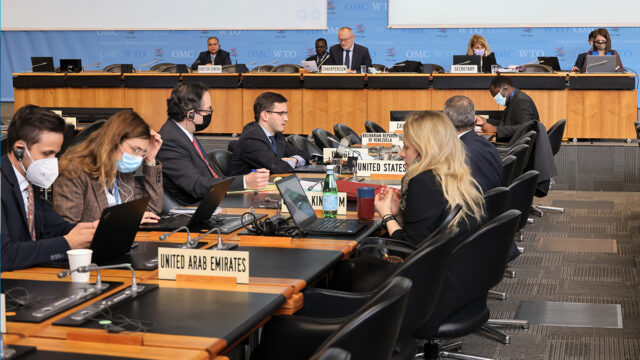- The underfill mechanism deals with cases when the fill rate of a tariff rate quota in any given year is below 65% for two consecutive years or the fill rate is not notified by the importing member
- Under the agreement, in the importing WTO member may be required to change the management of its TRQs to demonstrate that market circumstances rather than quota administration are contributing to the underfill
World Trade Organization members reached an agreement on March 31 to help address continued “underfill” of tariff rate quotas (TRQs) on agricultural imports.
The decision by the General Council marks the end of long discussions on unfinished business related to the 2013 Understanding on Tariff Rate Quota Administration, also known as the Bali TRQ Decision adopted at the WTO’s 9th Ministerial Conference in Bali, Indonesia. The 2013 Understanding sought to address cases where importing members’ quotas are persistently underfilled.
The underfill mechanism deals with cases when the fill rate of a tariff rate quota (TRQ) in any given year is below 65% for two consecutive years or the fill rate is not notified by the importing member. TRQs allow certain agricultural goods to be imported at lower duties up to a specified amount, with increased duties applied to amounts over the limit.
WTO members’ average fill rate of all WTO TRQs during 2014-2019 stood at 53%. Based on the secretariat’s September 2020 study, close to 200 TRQs with fill rate below 65% could have theoretically been subject to the Bali TRQ Decision underfill mechanism in 2018.
Under the new agreement, in the absence of an improvement in the fill rate or a satisfactory resolution to the problem, the importing WTO member may be required to change the management of its TRQs to demonstrate that market circumstances rather than quota administration are contributing to the underfill.
The “unfinished business” addressed by the General Council’s decision concerned future operation of paragraph 4 of the Bali TRQ Decision on the underfill mechanism, setting out importing members’ obligations at the “final” stage of the mechanism to deal with chronic underfill (fill rate below 65% for three consecutive years, little increase in fill rates during that period). The key outstanding issue on paragraph 4 was how to arrive at “closure” on underfill for a developing importing member that does not achieve the required increase in the fill rate in the final stage of the mechanism.
WTO members agreed on several elements on transparency and notification practices to improve utilization of tariff quotas during a 2017-19 review of the implementation of the Bali TRQ decision. But they could not agree on how the final stage of the underfill mechanism should work.
Members achieved a breakthrough at a reconvened 100th meeting of the Committee on Agriculture on March 29, removing all remaining obstacles to a deal on the underfill mechanism. The draft deal was transmitted to the General Council for its consideration and approval.
Costa Rica’s proposal in 2021 (G/AG/32), which forms part of the final deal, stated that an importing developing member not meeting the required increase in fill rate after two years will be subject to the standard requirement set out in the first sentence of paragraph 4(1), if requested by interested exporting members.
In the absence of such a request, the concern should be marked as closed.
At the Agriculture Committee meeting on March 29, the proposal gained universal support from all WTO members. Many delegations underlined that it provided a pragmatic and balanced solution to improve the TRQ fill rate while allowing adequate space for special and differential treatment for developing countries.









